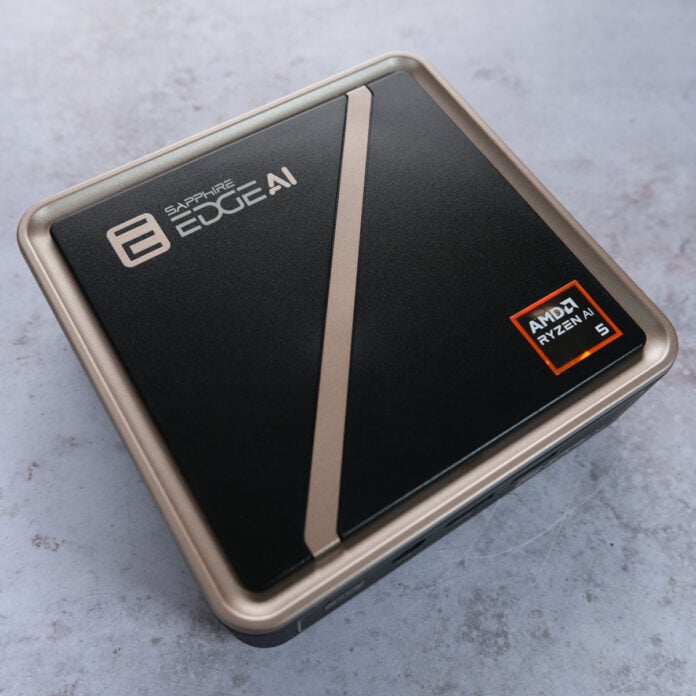The world of computing has irrecoverably changed in the wake of artificial intelligence and system manufacturers are responding in kind with PCs ready for the new age. Key among them is Sapphire with its Edge AI mini PC series, which promises to equip businesses and consumers alike with the power necessary for the modern era in a conveniently tiny package.
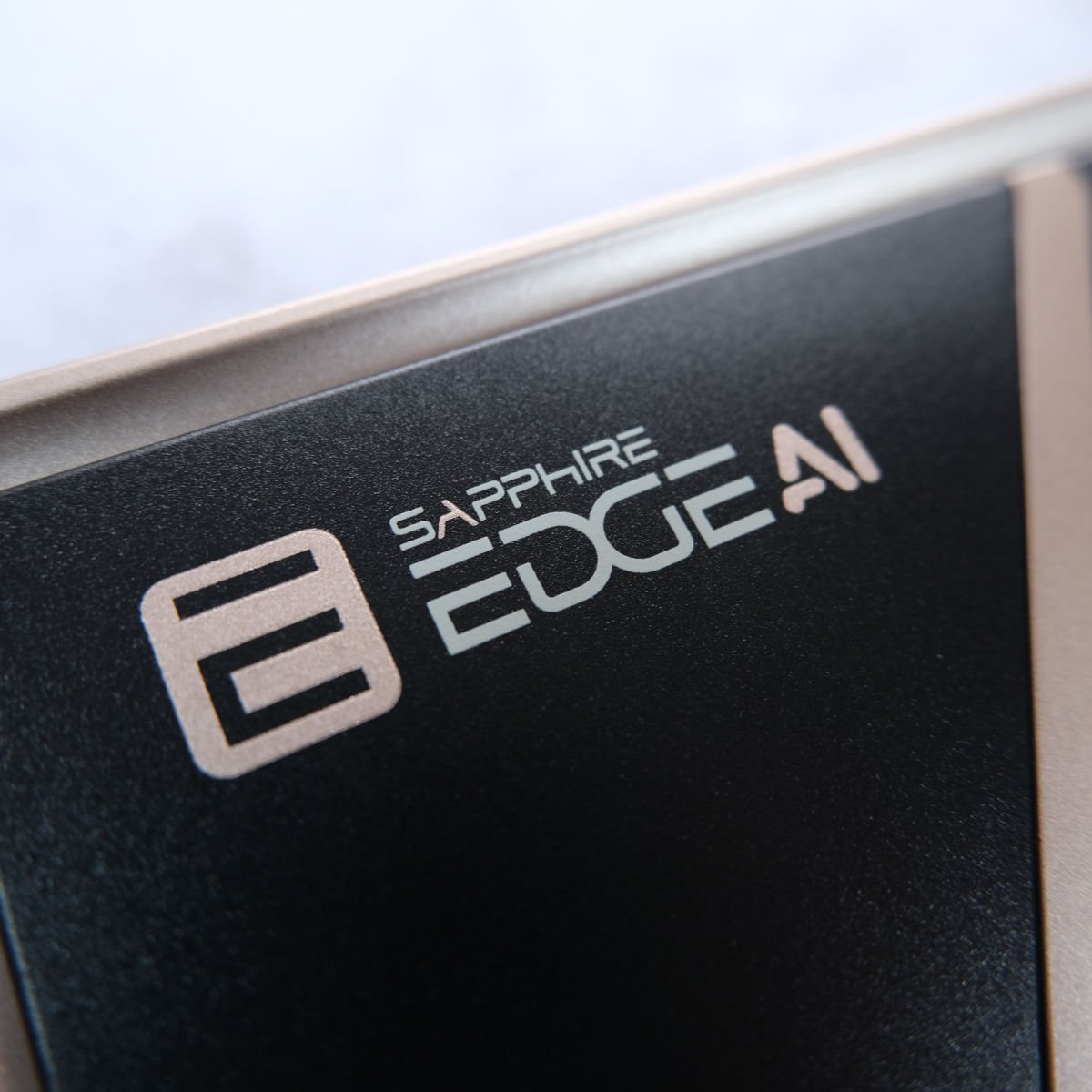

Sapphire Edge AI 340
£439
Pros
- Good CPU performance
- 50TOPS NPU
- Solid connectivity
- Cool and quiet under load
- Small, high-quality chassis
Cons
- Limited integrated graphics
- No SD card slot
Club386 may earn an affiliate commission when you purchase products through links on our site.
How we test and review products.
I’m taking a look at Edge AI 340, the base unit for Sapphire’s lineup. There are more powerful alternatives available, namely Edge AI 350 and Edge AI 370, which each offer increases in processor and graphics performance at a higher cost. Best known for producing some of the finest Radeon graphics cards on the market, Sapphire’s foray into mini PCs is full of intrigue as these itty-bitty systems are experiencing an AI-fuelled boom.
Specifications
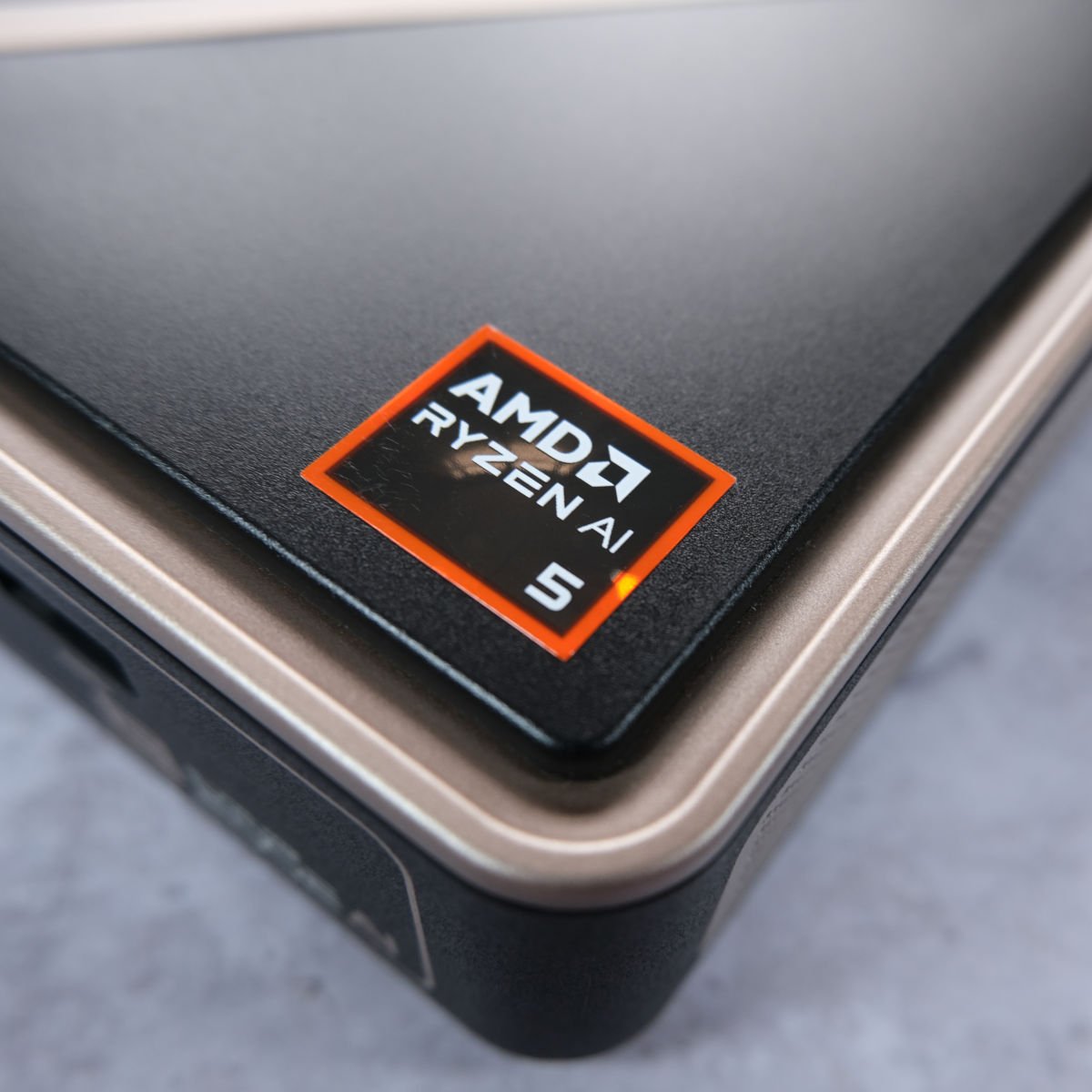
Edge AI 340’s name reflects its SoC, sporting an AMD Ryzen AI 5 340. The chip comes with six cores (3 Zen 5, 3 Zen 5c), 12 threads, with maximum clock speeds of up to 3.4/4.8GHz depending on the core type.
Radeon 840M comes part and parcel with this chip, marrying RDNA 3.5 integrated graphics with the Zen 5/5c cores. However, this is not a particularly powerful iGPU, with just four compute units under its proverbial belt, a quarter of the 16 CUs found on Radeon 890M via Ryzen AI 9 HX 370.
When it comes to AI TOPS, though, Ryzen AI 5 340 matches its siblings with the same XDNA2 NPU capable of up to 50TOPS of performance. This is comfortably above the 40TOPS requirement for Copilot+ certification, enabling support for AI features current, like those in Adobe Photoshop and DaVinci Resolve Studio, as well as upcoming, such as Windows Recall.
AMD ships Ryzen AI 5 340 with a default TDP of 28W but allows manufacturers to tweak this value from 15 to 54W. Free from the thermal confines of a laptop, Sapphire takes advantage of available headroom, topping out at 40W in my testing. This leaves 14W on the table in terms of the chip’s maximum but this limit is undoubtedly in service of catering to the system’s efficiency and cooling apparatus.
| Edge AI 340 | |
|---|---|
| CPU | AMD Ryzen AI 5 340 |
| GPU | AMD Radeon 840M |
| NPU | Up to 50TOPS |
| RAM | Up to 96GB, dual channel DDR5 SO-DIMM |
| Storage | M.2 2280 (x1) M.2 2242 (x1) M.2 2230 (x1)* |
| Front Ports | 3.5mm Mic-in/Headphone-out (x1) USB-A 10Gb (x2) |
| Rear Ports | HDMI 2.1 (x1) RJ45 2.5Gb (x1) USB-C 40Gb, w/ DP Alt Mode and PD 3.0 (x2) USB-A 10Gb (x1) USB-A 480Mb (x1 |
| Features | Bluetooth 5.2 Kensington Security Slot VESA Mount Wi-Fi 6E |
| Dimensions | 117 x 111 x 30mm |
| Weight | 415g |
| Price | From £439 |
As is often the case with mini-PC solutions, Sapphire offers up its Edge AI systems as barebone units, meaning they arrive without memory, storage, or OS. System integrators will step in and plug the gaps with turnkey variants, or you can slot in your own compatible components out of your own pocket.
Capable of running up to 96GB of DDR5 SO-DIMM in a dual-channel configuration, there’s ample scope for running all but the most advanced AI models. The same goes for storage too, with support for PCIe Gen 4 M.2 SSDs across a single 2280 and 2242 slot.
At the time of writing, you can pick up an 8GB DDR5-5600 SODIMM stick for ~£31 and a 500GB PCIe Gen 4 SSD for ~£34.99. Without taking into consideration the cost of Windows 11, or opting for a free Linux distro, this constitutes a £65 additional spend on top of the system’s £439 RRP, making Edge AI 340’s potential total closer to £500.
In the context of the broader market, this cost is on par with a turnkey MSI Cubi NUC 1M featuring a Core 5 120U and complementary Windows 11 licence. That’s good going considering this system is smaller, more powerful, and boasts much of the same connectivity.
Design
Let’s talk Edge AI 340’s chassis and ports. This is a handsomely petite PC, measuring 117 x 111 x 30mm and weighing 415g. Suffice to say, this system slots into practically any space without much of a footprint. You can also tuck it away behind a monitor via VESA mounting too if you’d prefer. It’s easy to see why the mini PC boom is truly underway; for many an office, the space-saving, low-power and high-performance credentials make for an attractive desktop tower replacement. Think of it as the guts of a laptop in a tiny little box.
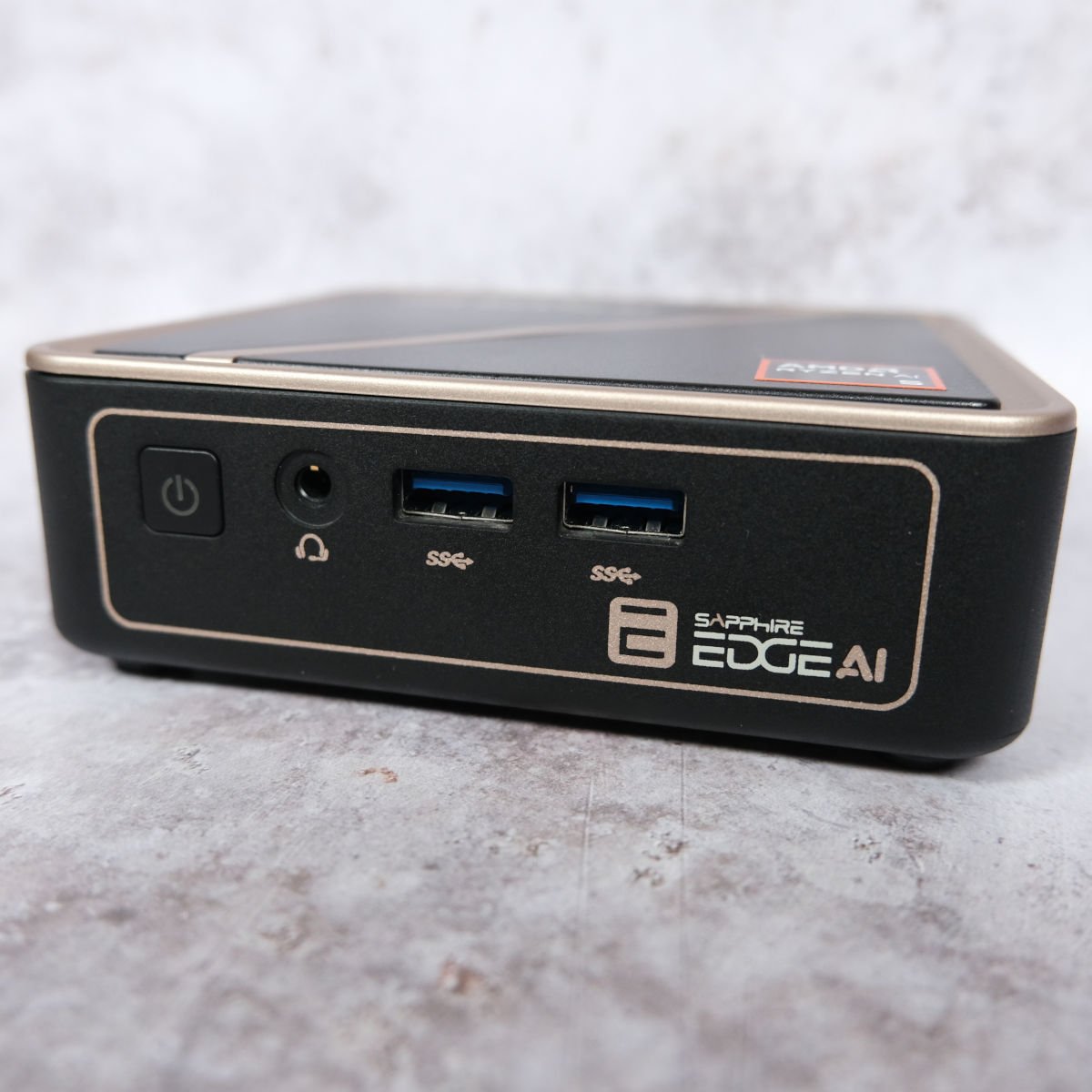
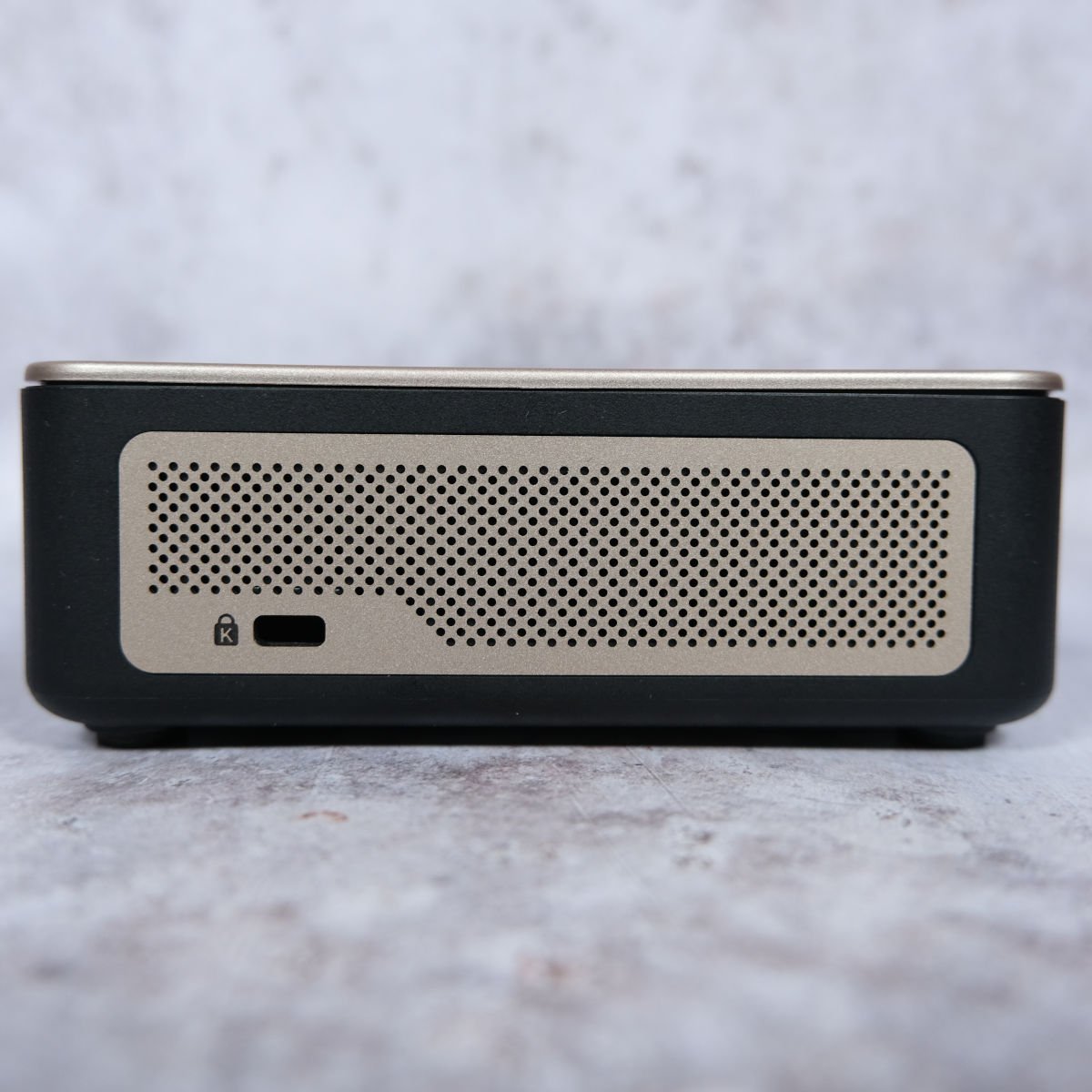
Round front is a satisfyingly clicky power button, two USB-A 10Gb ports and a 3.5mm combo port. I do so wish Sapphire included an (micro)SD card slot too for creator convenience, but the system requires you keep a trusty adapter/dongle handy.
The sides feature small but plentiful ventilation cut outs amidst golden grills. Look a little closer, though, and you’ll find a Kensington Security Slot, too. The black-gold colour scheme Sapphire adopts for its Edge AI PCs is classy, and reminds me in particular of Deus Ex: Human Revolution’s iconic colour scheme. Could this system fit into Adam Jensen’s office? Certainly.
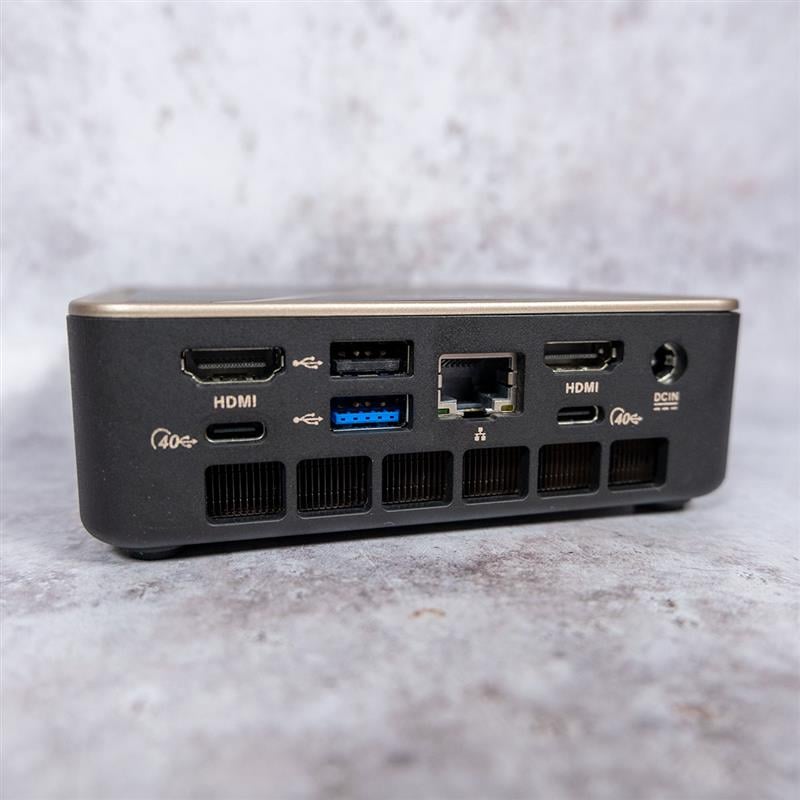
Checking out the back, there’s more ventilation but also the majority of ports. The device comes with two USB-C 40Gb ports, complete with PD 3.0 support. Meanwhile, a single USB-A 10Gb and 480Mb round off peripheral connectivity.
In terms of display outputs, Edge AI 340 arrives with two HDMI 2.1 ports. This is a welcome selection, but you can also leverage both USB-C ports as additional connectors via DP Alt Mode.
For wired networking, Edge AI 340 has a 2.5Gb RJ45 at its disposal. Pursuing cordless is easy thanks to WiFi 6E support with Bluetooth 5.2 rounding off wireless connections. There are no external aerials to boost signal quality but I’ve had no issues running the PC at speed on my home network.
Upgradability
Coming full circle, accessing the majority of Edge AI 340’s internals is toolless and simple. The magnetic cover takes some force to remove, and a small lip for easy removal wouldn’t go amiss, but once it’s off both RAM and storage reveal themselves.
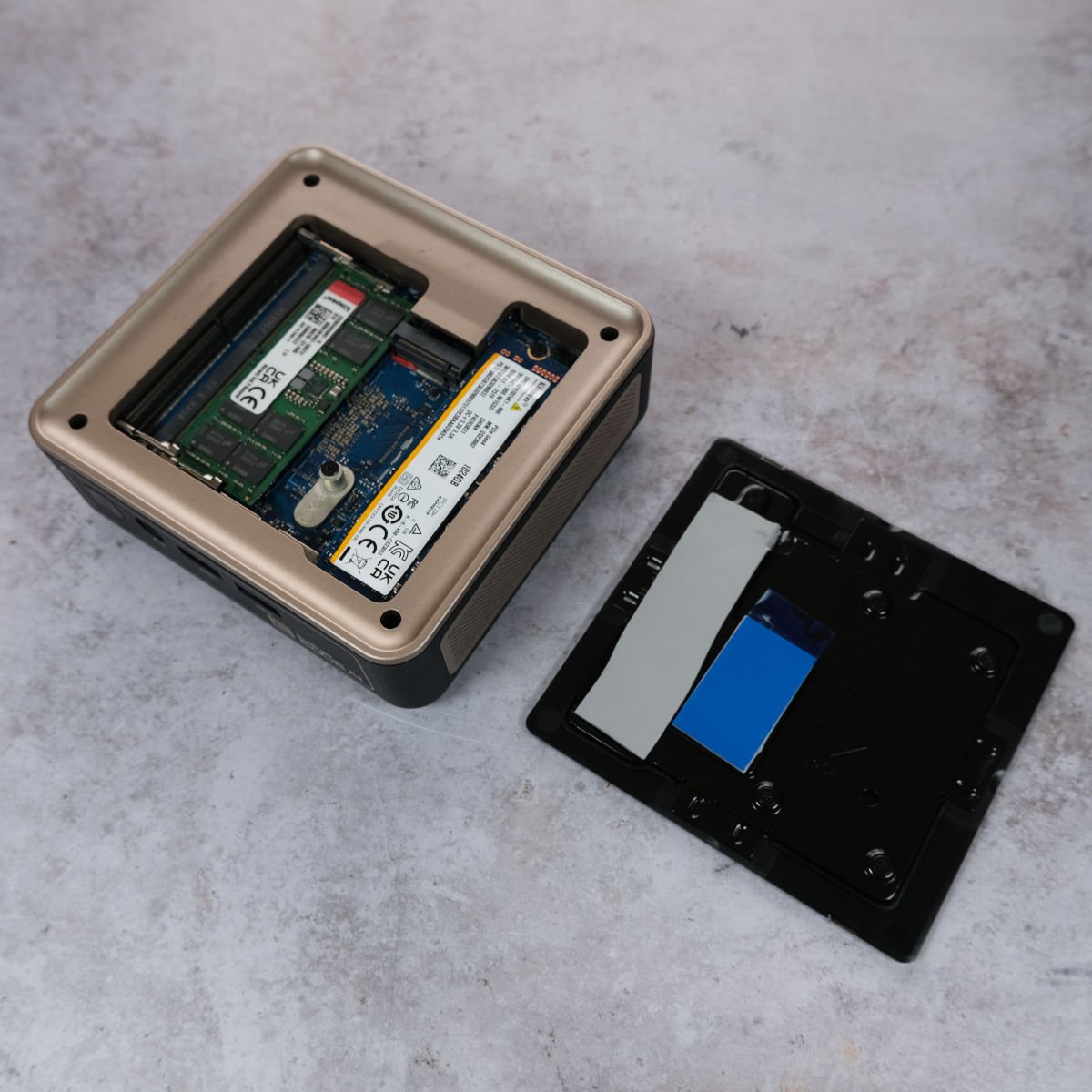
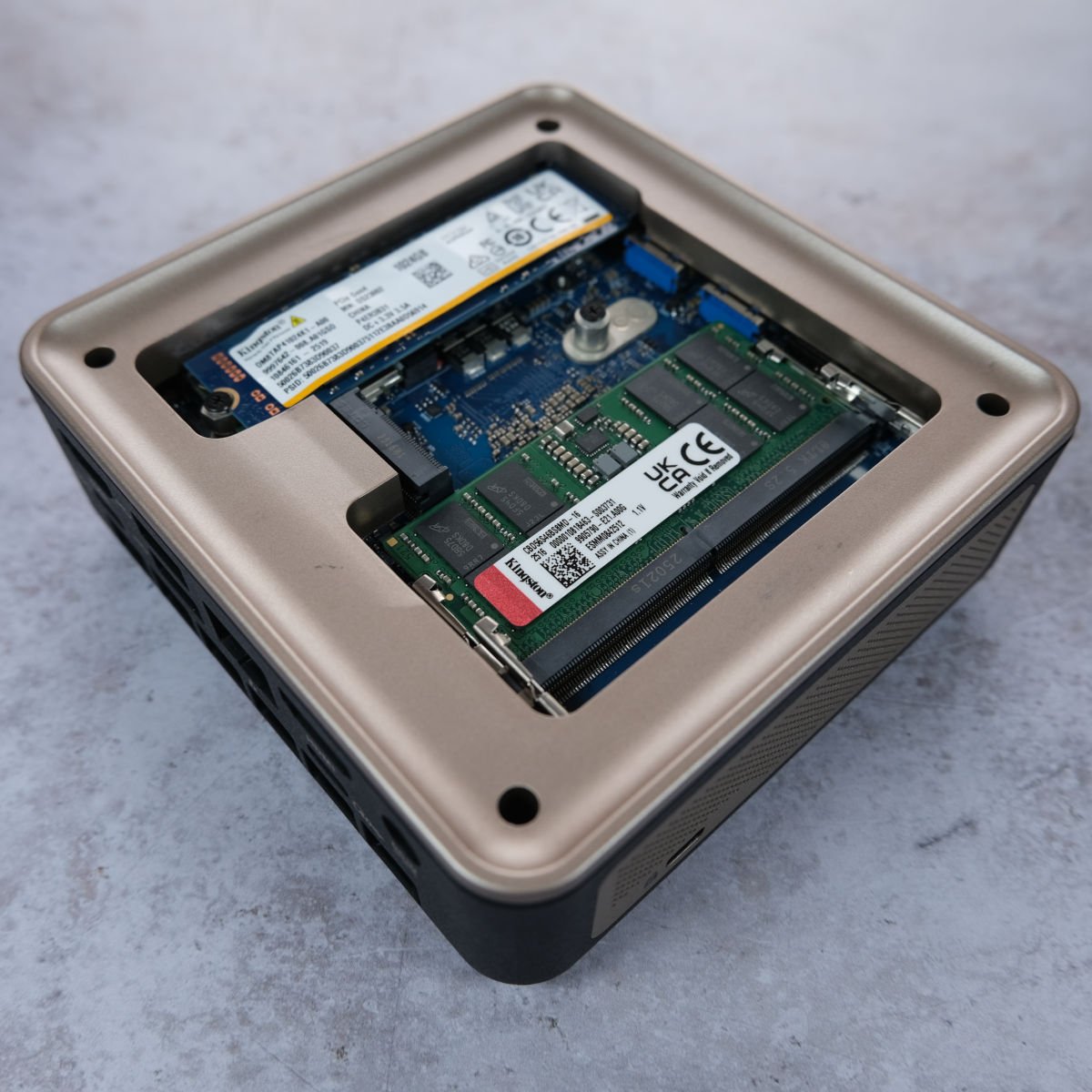
Installing memory modules naturally doesn’t require any tools but you will need a screwdriver handy for storage. Sapphire includes two thermal pads for the 2280 and 2242 M.2 slot, which sandwich themselves between the system’s lid and SSD(s).
On the underside of Edge AI 340, you’ll see the PC’s fan cooler through the ventilation cut out, surrounded by four rubber feet. Getting to the heatsink et al. isn’t something most users should need to do but the apparatus is accessible via four screws up top.
Performance
Edge AI 340’s absolute performance will of course depend on memory or storage configuration. With this in mind, my test sample sports specifications that will demonstrate a rough baseline of what the system is capable of.
More specifically, my sample features 16GB of DDR5-5600 CL46 running in a single-channel configuration and a midrange 1TB PCIe Gen 4 SSD. While I’d prefer to run RAM in dual-channel, this setup is sufficient for everyday computing.
Application
| Benchmark | Sapphire Edge AI 340 (Ryzen AI 5 340) | Geekom GT1 Mega (Core Ultra 9 185H) | Geekom IT12 2025 (Core i7-1280P) |
|---|---|---|---|
| CPU-Z | 763.1 single-thread 4,966.3 multi-thread | 702.3 single-thread 7,622.9 multi-thread | 611.4 single-thread 5,174.3 multi-thread |
| Cinebench 2024 | 108 single-core 670 multi-core | 109 single-core 932 multi-core | 93 single-core 558 multi-core |
| Cinebench R23 | 1,913 single-core 11,449 multi-core | 1,739 single-core 18,524 multi-core | 1,504 single-core 8,516 multi-core |
| AIDA64 | 43,238MB/s read 41,610MB/s write 36,587MB/s copy 92.5ns latency | 80,782MB/s read 74,139MB/s write 73,306MB/s copy 140.5ns latency | 44,634MB/s read 44,988MB/s write 45,622MB/s copy 86.9ns latency |
| AS SSD | 4,455MB/s seq. read 3,276MB/s seq. write | 5,239MB/s seq. read 5,169MB/s seq. write | 4,070MB/s seq. read 3,887MB/s seq. write |
| PCMark 10 | 6,248 | 7,269 | 5,182 |
| 3DMark Fire Strike | 3,713 | 7,097 | 4,785 |
| 3DMark Night Raid | 14,761 | 31,531 | 16,234 |
| 3DMark Time Spy | 1,635 | 3,859 | 1,781 |
Both RAM and SSD perform within expectations for their advertised specifications. Single-channel operation is the most notable bottleneck here, affecting AIDA64 and PCMark 10 results. Swapping in another stick should see performance in both applications rise.
With six cores to play with, Ryzen 5 AI 340 was never going to top the Cinebench 2024 charts. However, it does enjoy a solid lead in single and multi-core benchmarks over the similarly-priced Intel alternatives. In single-core Cinebench, the Sapphire Edge even gives the much dearer Core Ultra 9-powered Geekom GT1 Mega a run for its money.
It’s in the more graphics-dependent benchmarks that Edge AI 340 struggles. Radeon 840M costs the PC victory in every 3DMark benchmark against the much older Iris Xe graphics in Geekom IT12 2025.
Gaming
Though Sapphire doesn’t explicitly advertise Edge AI 340’s gaming capabilities, the current wave of mini PCs are in effect do-it-all units that can dabble in just about everything, including some casual gaming. To be clear mileage will vary – Radeon 840M doesn’t offer much in the way of graphics grunt and is in fact weaker than the Steam Deck according to my testing – but that doesn’t rule out gaming entirely.
I’ve laid out the graphics presets used for each game in the table below, measuring frame rate in each title using their built-in benchmark at 1080p.
| Game | Frame rate (Min. / Avg.) |
|---|---|
| Cyberpunk 2077 (Steam Deck) | 18 / 21fps |
| Final Fantasy XIV (Standard, Laptop) | 18 / 28fps |
| Forza Horizon 5 (Low) | 36 / 41fps |
| Rainbow Six Siege X (Low) | 59 / 76fps |
Some modern titles like Cyberpunk 2077 and Final Fantasy XIV are simply too heavy for Edge AI 340 to handle, whereas others are playable including Forza Horizon 5 and Rainbow Six Siege X. While some experiences are clearly out of reach for the system, there are plenty of ultra lightweight titles such as Balatro, Slay the Spire, and more that run without a hitch.
For those that desire more power, I’d turn your attentions to Edge AI 370 and 350. Those systems boast far more powerful processors and graphics, the former in particular shares the same Radeon 890M iGPU as ROG Xbox Ally X. Alternatively, you could sidestep the limitations of local silicon via the cloud through a service such as Nvidia GeForce Now.
BIOS
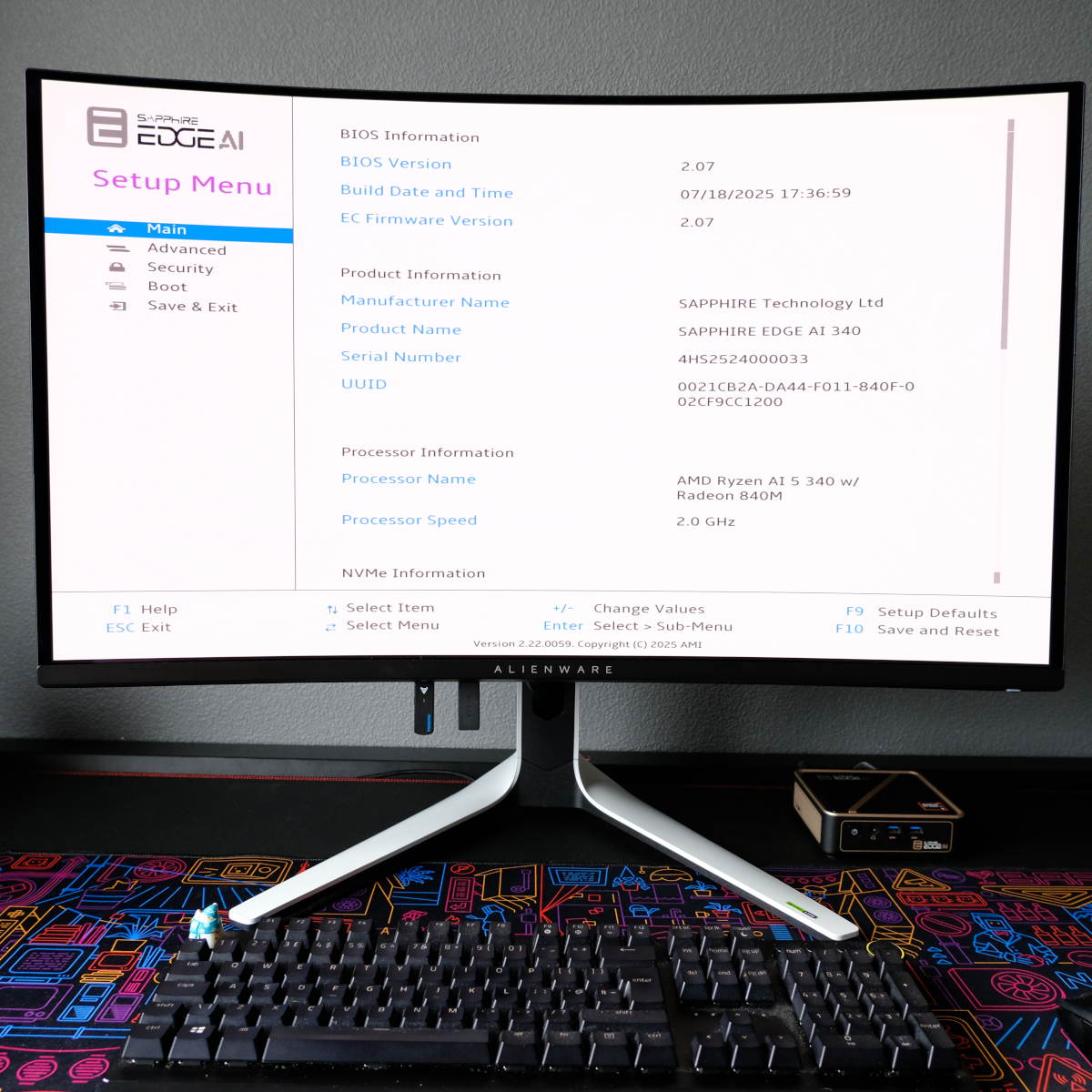
Sapphire gives Edge AI 340’s BIOS a little extra zhuzh with a modern interface, complete with mouse support. It’s not on the same level as the brand’s desktop motherboards, such as Nitro+ B850A WiFi 7, but there’s a useful smattering of options here as well as general system information, and the BIOS is a marked step-up from the vanilla offerings of many rival mini PCs.
Vitals
Sitting idle, Edge AI 340 is both silent and cool atop my desk. Far as I can tell, the PC’s fan doesn’t kick in until CPU temperatures reach above 50°C which is far above the 39°C system ambient.
Piddly power consumption makes these low temperatures possible. As Edge AI 340 waits for a task, it’ll sip a mere 6.6W from the wall.
In general use, the fan will occasionally spin up as processor load increases. Although, the blower never gets louder than ~30dBA, tantamount to a whisper. Note that higher resolutions will increase pressure on the SoC, with the blades getting to work more often at 4K than 1080p in my experience.
| Idle | Load (Max.) | |
|---|---|---|
| CPU temperature | 39°C | 73-77°C |
| Noise | N/A | 36-39dBA |
| Power consumption | 6.6W | 55-60W |
Edge AI 340 handles the pressures of Cinebench 2024 with a good amount of poise. Pulling 55W from the wall, the system’s operating temperatures peak at 77°C while noise levels rise to a 39dBA maximum.
Gaming proves less intense for the PC overall, as maximum temperatures and noise respectively drop to 73°C and 36dBA. However, peak power consumption does rise to 60W.
These are entirely respectable results for a system of this literal stature. I’d love to see the system running with a less aggressive fan curve on account of Ryzen AI 5 340’s 100°C Tjmax but there’s unfortunately no way to meaningfully tweak the profile.
Conclusion
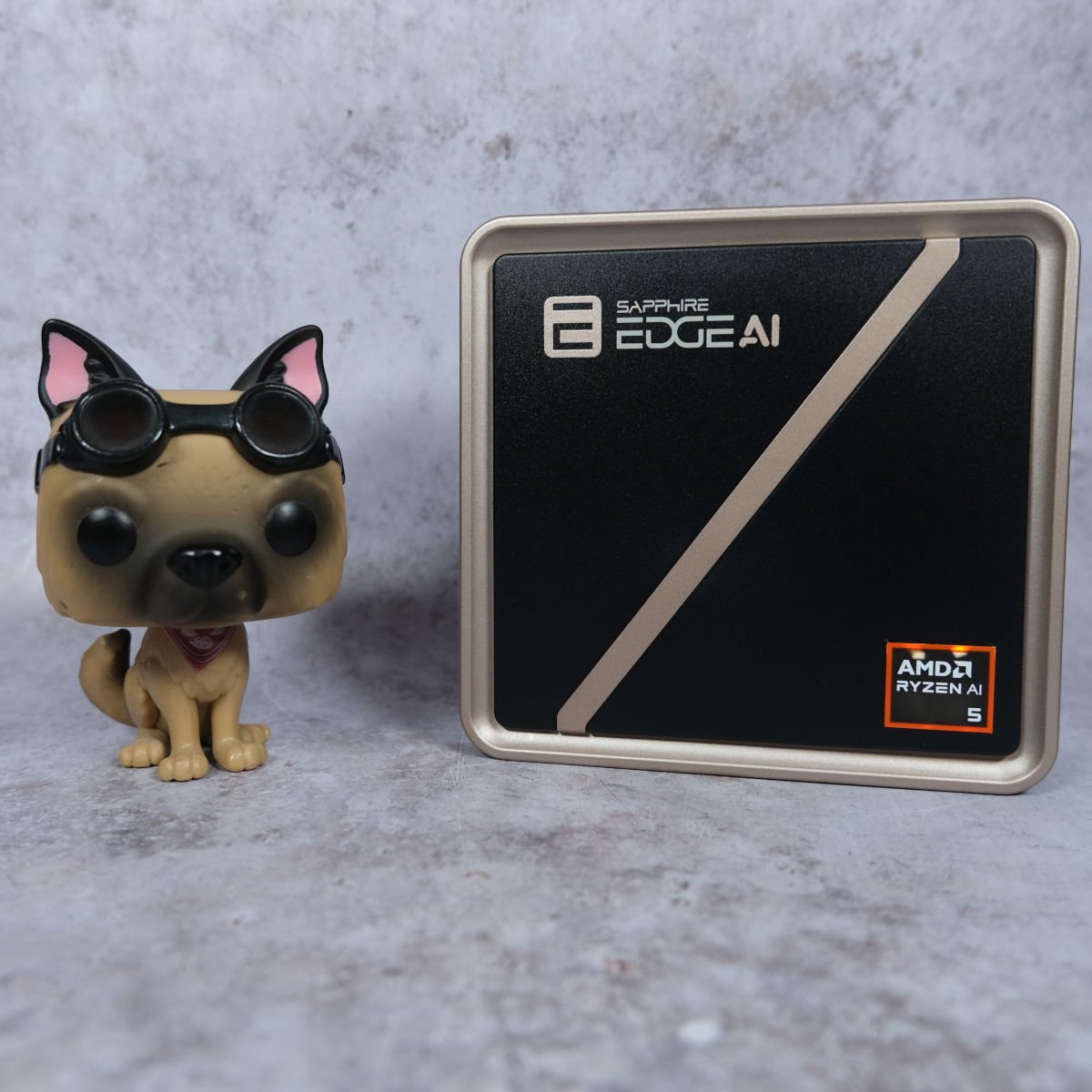
Sapphire has crafted a solid floor for its new batch of mini PCs via Edge AI 340. With some RAM and storage in tow, the system delivers all the performance most will need to face the demands of modern computing in a stylish, small chassis.
What Ryzen AI 5 340 lacks in gaming horsepower, it makes up for elsewhere. The CPU, GPU and NPU combo of this SoC is powerful enough to tackle everyday tasks regardless of whether you plan to leverage some local AI inference in your workflow.
It’s unclear how much Edge AI 340 will retail for from system integrators as a complete kit, but the base £439 RRP for barebones is competitive relative to alternatives on the market. That said, the enthusiast in me is curious as to how much more performance Edge AI 350 and Edge AI 370 offer at £539 and £649, respectively.
I can see Edge AI 340 proving popular in the B2B market, namely in educational, retail, and office environments. However, there’s definitely reason to consider the system as a consumer too, whether you’re considering a replacement to the long-serving family PC or fancy a petite system with respectable punch.


